1.2: Project Organization
- Page ID
- 148790
\( \newcommand{\vecs}[1]{\overset { \scriptstyle \rightharpoonup} {\mathbf{#1}} } \)
\( \newcommand{\vecd}[1]{\overset{-\!-\!\rightharpoonup}{\vphantom{a}\smash {#1}}} \)
\( \newcommand{\dsum}{\displaystyle\sum\limits} \)
\( \newcommand{\dint}{\displaystyle\int\limits} \)
\( \newcommand{\dlim}{\displaystyle\lim\limits} \)
\( \newcommand{\id}{\mathrm{id}}\) \( \newcommand{\Span}{\mathrm{span}}\)
( \newcommand{\kernel}{\mathrm{null}\,}\) \( \newcommand{\range}{\mathrm{range}\,}\)
\( \newcommand{\RealPart}{\mathrm{Re}}\) \( \newcommand{\ImaginaryPart}{\mathrm{Im}}\)
\( \newcommand{\Argument}{\mathrm{Arg}}\) \( \newcommand{\norm}[1]{\| #1 \|}\)
\( \newcommand{\inner}[2]{\langle #1, #2 \rangle}\)
\( \newcommand{\Span}{\mathrm{span}}\)
\( \newcommand{\id}{\mathrm{id}}\)
\( \newcommand{\Span}{\mathrm{span}}\)
\( \newcommand{\kernel}{\mathrm{null}\,}\)
\( \newcommand{\range}{\mathrm{range}\,}\)
\( \newcommand{\RealPart}{\mathrm{Re}}\)
\( \newcommand{\ImaginaryPart}{\mathrm{Im}}\)
\( \newcommand{\Argument}{\mathrm{Arg}}\)
\( \newcommand{\norm}[1]{\| #1 \|}\)
\( \newcommand{\inner}[2]{\langle #1, #2 \rangle}\)
\( \newcommand{\Span}{\mathrm{span}}\) \( \newcommand{\AA}{\unicode[.8,0]{x212B}}\)
\( \newcommand{\vectorA}[1]{\vec{#1}} % arrow\)
\( \newcommand{\vectorAt}[1]{\vec{\text{#1}}} % arrow\)
\( \newcommand{\vectorB}[1]{\overset { \scriptstyle \rightharpoonup} {\mathbf{#1}} } \)
\( \newcommand{\vectorC}[1]{\textbf{#1}} \)
\( \newcommand{\vectorD}[1]{\overrightarrow{#1}} \)
\( \newcommand{\vectorDt}[1]{\overrightarrow{\text{#1}}} \)
\( \newcommand{\vectE}[1]{\overset{-\!-\!\rightharpoonup}{\vphantom{a}\smash{\mathbf {#1}}}} \)
\( \newcommand{\vecs}[1]{\overset { \scriptstyle \rightharpoonup} {\mathbf{#1}} } \)
\( \newcommand{\vecd}[1]{\overset{-\!-\!\rightharpoonup}{\vphantom{a}\smash {#1}}} \)
\(\newcommand{\avec}{\mathbf a}\) \(\newcommand{\bvec}{\mathbf b}\) \(\newcommand{\cvec}{\mathbf c}\) \(\newcommand{\dvec}{\mathbf d}\) \(\newcommand{\dtil}{\widetilde{\mathbf d}}\) \(\newcommand{\evec}{\mathbf e}\) \(\newcommand{\fvec}{\mathbf f}\) \(\newcommand{\nvec}{\mathbf n}\) \(\newcommand{\pvec}{\mathbf p}\) \(\newcommand{\qvec}{\mathbf q}\) \(\newcommand{\svec}{\mathbf s}\) \(\newcommand{\tvec}{\mathbf t}\) \(\newcommand{\uvec}{\mathbf u}\) \(\newcommand{\vvec}{\mathbf v}\) \(\newcommand{\wvec}{\mathbf w}\) \(\newcommand{\xvec}{\mathbf x}\) \(\newcommand{\yvec}{\mathbf y}\) \(\newcommand{\zvec}{\mathbf z}\) \(\newcommand{\rvec}{\mathbf r}\) \(\newcommand{\mvec}{\mathbf m}\) \(\newcommand{\zerovec}{\mathbf 0}\) \(\newcommand{\onevec}{\mathbf 1}\) \(\newcommand{\real}{\mathbb R}\) \(\newcommand{\twovec}[2]{\left[\begin{array}{r}#1 \\ #2 \end{array}\right]}\) \(\newcommand{\ctwovec}[2]{\left[\begin{array}{c}#1 \\ #2 \end{array}\right]}\) \(\newcommand{\threevec}[3]{\left[\begin{array}{r}#1 \\ #2 \\ #3 \end{array}\right]}\) \(\newcommand{\cthreevec}[3]{\left[\begin{array}{c}#1 \\ #2 \\ #3 \end{array}\right]}\) \(\newcommand{\fourvec}[4]{\left[\begin{array}{r}#1 \\ #2 \\ #3 \\ #4 \end{array}\right]}\) \(\newcommand{\cfourvec}[4]{\left[\begin{array}{c}#1 \\ #2 \\ #3 \\ #4 \end{array}\right]}\) \(\newcommand{\fivevec}[5]{\left[\begin{array}{r}#1 \\ #2 \\ #3 \\ #4 \\ #5 \\ \end{array}\right]}\) \(\newcommand{\cfivevec}[5]{\left[\begin{array}{c}#1 \\ #2 \\ #3 \\ #4 \\ #5 \\ \end{array}\right]}\) \(\newcommand{\mattwo}[4]{\left[\begin{array}{rr}#1 \amp #2 \\ #3 \amp #4 \\ \end{array}\right]}\) \(\newcommand{\laspan}[1]{\text{Span}\{#1\}}\) \(\newcommand{\bcal}{\cal B}\) \(\newcommand{\ccal}{\cal C}\) \(\newcommand{\scal}{\cal S}\) \(\newcommand{\wcal}{\cal W}\) \(\newcommand{\ecal}{\cal E}\) \(\newcommand{\coords}[2]{\left\{#1\right\}_{#2}}\) \(\newcommand{\gray}[1]{\color{gray}{#1}}\) \(\newcommand{\lgray}[1]{\color{lightgray}{#1}}\) \(\newcommand{\rank}{\operatorname{rank}}\) \(\newcommand{\row}{\text{Row}}\) \(\newcommand{\col}{\text{Col}}\) \(\renewcommand{\row}{\text{Row}}\) \(\newcommand{\nul}{\text{Nul}}\) \(\newcommand{\var}{\text{Var}}\) \(\newcommand{\corr}{\text{corr}}\) \(\newcommand{\len}[1]{\left|#1\right|}\) \(\newcommand{\bbar}{\overline{\bvec}}\) \(\newcommand{\bhat}{\widehat{\bvec}}\) \(\newcommand{\bperp}{\bvec^\perp}\) \(\newcommand{\xhat}{\widehat{\xvec}}\) \(\newcommand{\vhat}{\widehat{\vvec}}\) \(\newcommand{\uhat}{\widehat{\uvec}}\) \(\newcommand{\what}{\widehat{\wvec}}\) \(\newcommand{\Sighat}{\widehat{\Sigma}}\) \(\newcommand{\lt}{<}\) \(\newcommand{\gt}{>}\) \(\newcommand{\amp}{&}\) \(\definecolor{fillinmathshade}{gray}{0.9}\)The LibreTexts consists of 12 field-specific libraries, a K-12 library (available in English) and a Spanish (Español) library. Table \(\PageIndex{1}\) lists the libraries and the URLs for reaching them directly:
| Library | URL |
|---|---|
| Biology | https://bio.libretexts.org/ |
| Business | https://biz.libretexts.org/ |
| Chemistry | https://chem.libretexts.org/ |
| Engineering | https://eng.libretexts.org/ |
| Español | https://espanol.libretexts.org/ |
| Geosciences | https://geo.libretexts.org/ |
| Global | https://query.libretexts.org/ |
| Humanities | https://human.libretexts.org/ |
| K12 Edducation | https://K12.libretexts.org/ |
| Mathematics | https://math.libretexts.org/ |
| Medicine (Human Health) | https://med.libretexts.org/ |
| Physics | https://phys.libretexts.org/ |
| Social Sciences | https://socialsci.libretexts.org/ |
| Statistics | https://stats.libretexts.org/ |
| Ukrayinska | https://ukrayinska.libretexts.org/ |
| Workforce | https://workforce.libretexts.org/ |
There are several other ways of reaching the library of your choice which we will describe on the next page
With the exception of the K-12 and Español, Global and Ukrayinska libraries, the content is organized in three primary sections: the Campus Bookshelves, the Bookshelves and Learning Objects. The Español, Global and Ukrayinska libraries contain machine translations of books found in the Bookshelves areas.
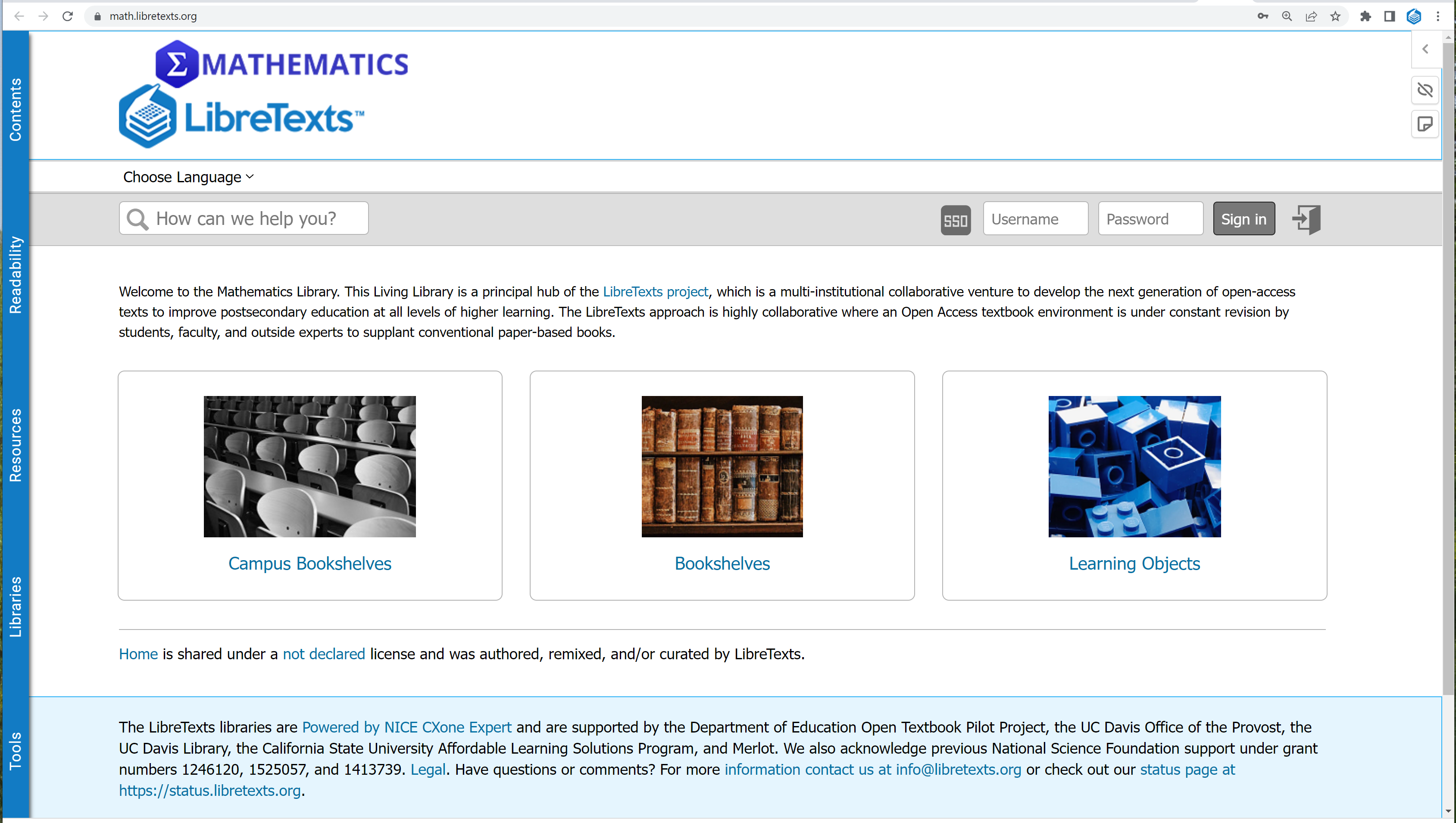
Campus Bookshelves
The content in the Campus Bookshelves is formulated as campus-dependent and faculty-dependent course shells with customized textbook remixes. These textbooks are customized by faculty, often in collaboration with developers on the LibreTexts team and may include content from any other sections of the LibreTexts libraries (both within and outside of the respective library where it resides).
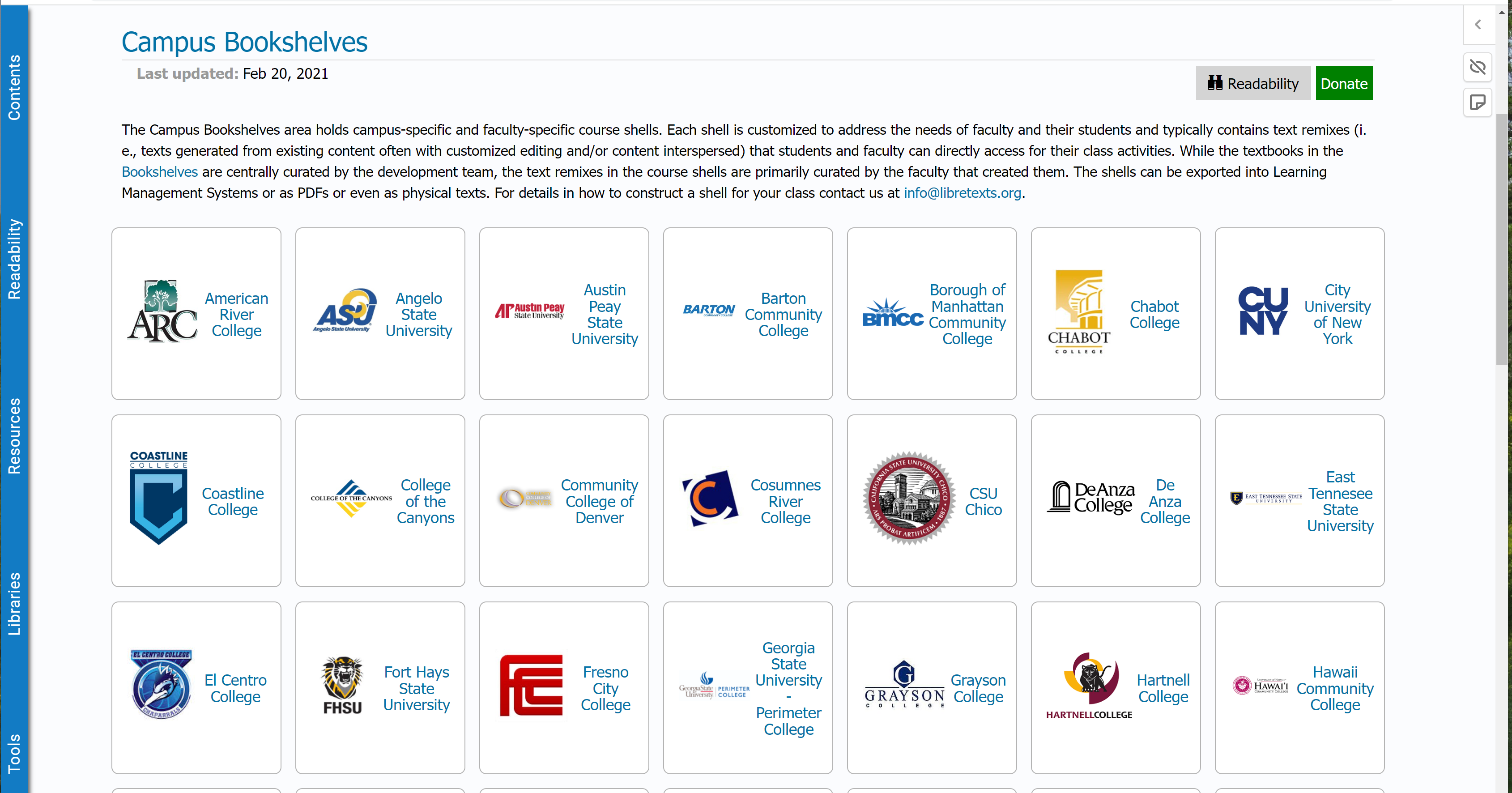
For the student, the Course shell is the “decoder” to the 100,000 pages of content in the libraries. While the texts in the Bookshelves are curated by the LibreTexts team and the greater LibreTexts community, the content in the Course Shells are intended to be curated by the faculty and campuses that "own" them. The full freedom to customize Course Shells enables faculty to construct Textbooks and Shells as they see fit. For example, the Chem 2BH course Shell at UCD includes much more than a simple textbook; it also includes an Agenda, homework assignments, worksheets, and the laboratory manual.
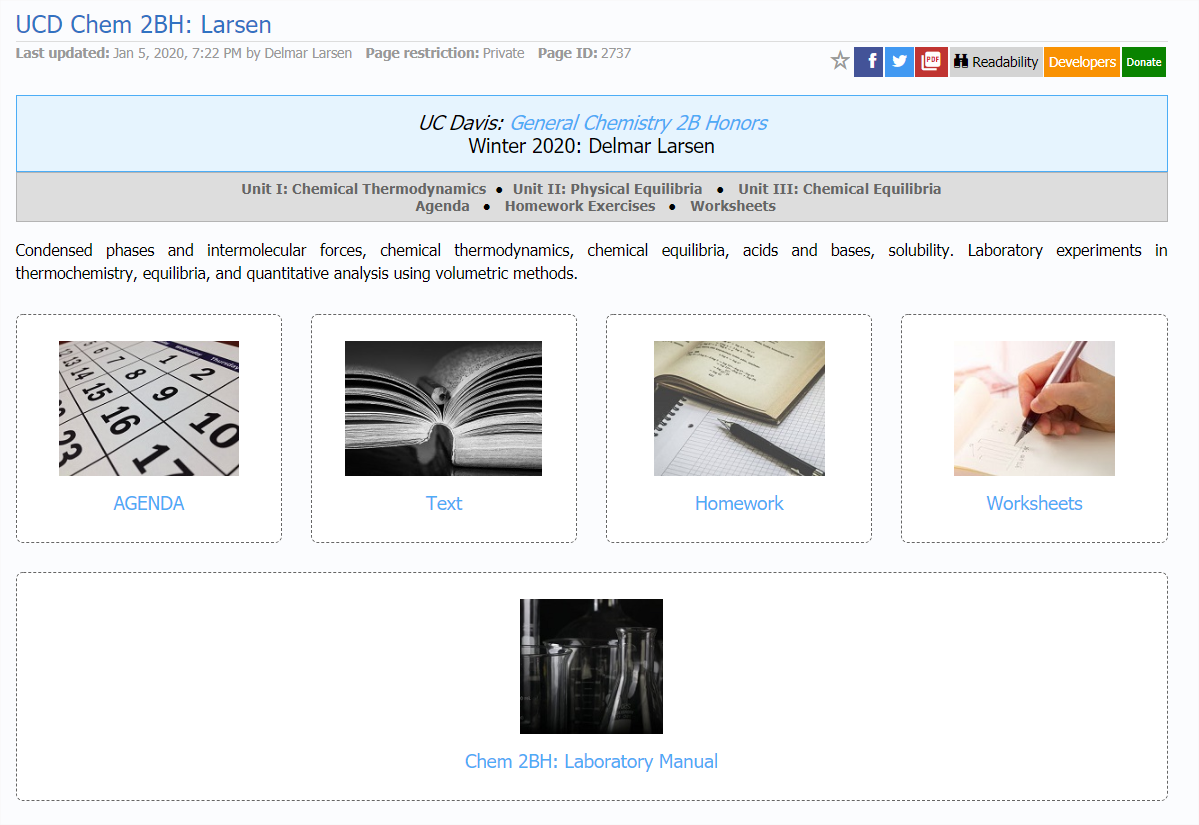
Bookshelves
This is where the LibreTexts books are stored. Instructors can either use these texts as constructed or they can use the OER Remixer to modify these materials and create a remix text that is customized for their course.
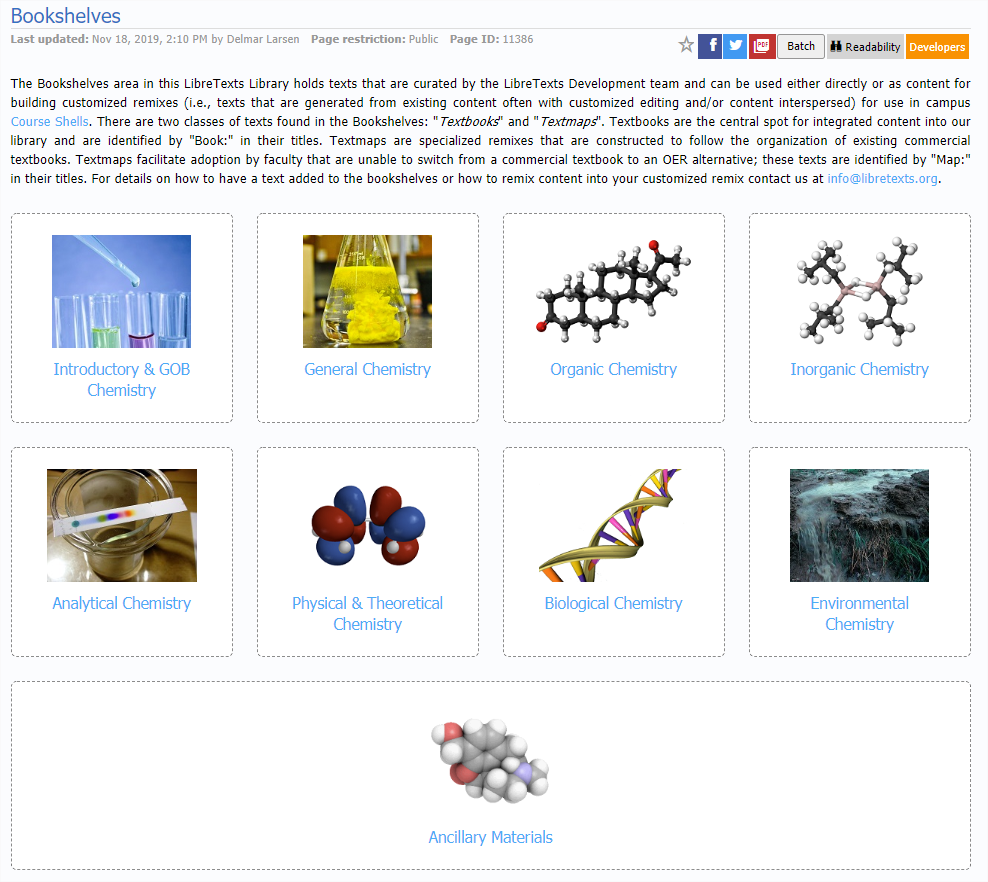
Textbooks vs. Textmaps
Some of the texts in the Bookshelves are titled "Book:" and some "Map:". The "books" are original OER textbooks that have been created by LibreTexts, or integrated into the LibreTexts (e.g., texts from OpenStax or the Open Textbook Library referatory). The content in these Books are largely original, although often heavily edited by editors to conform to project standards on presentation and error correction. Alternatively, "Maps" are remixes that are constructed and organized around existing commercial textbooks, but using existing OER content with light or heavy filling in of gaps in the library. The principal goal of the TextMaps is to provide an easy-to-adopt alternative to faculty’s existing textbook choices. Faculty that are too invested in commercial texts to switch to a new organization can adopt a Map.
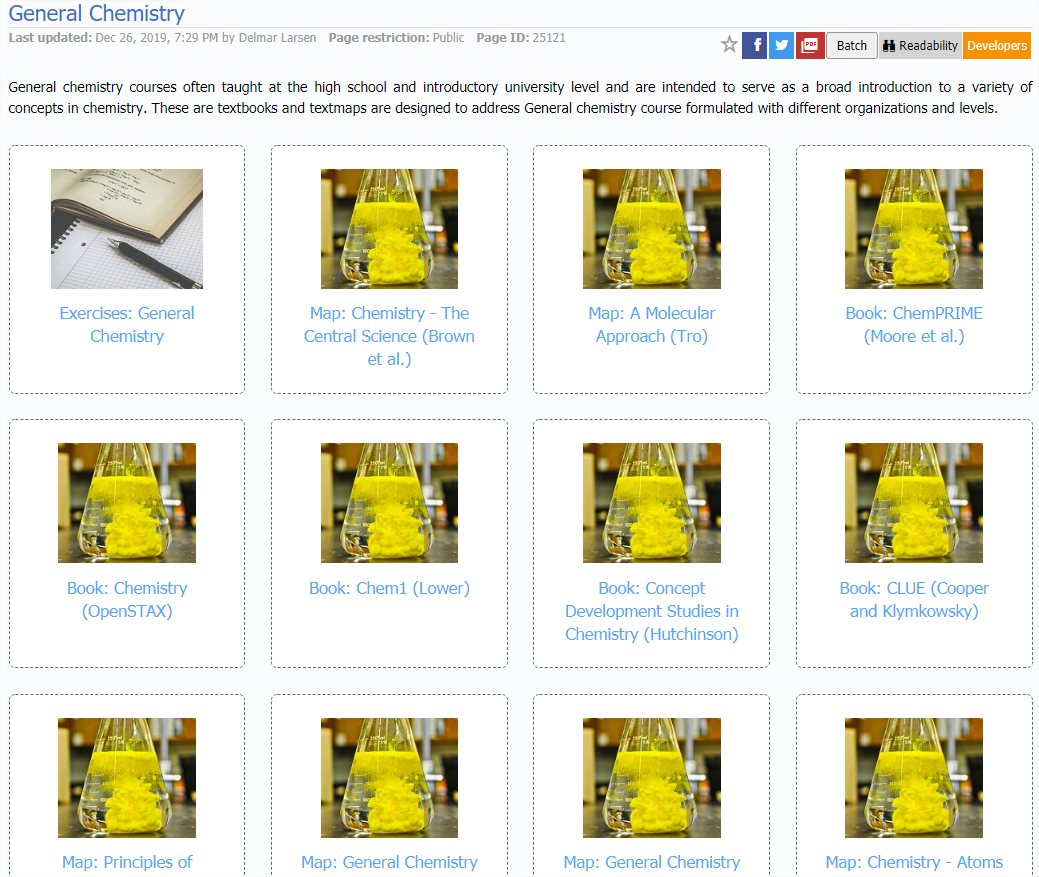
Learning Objects
These secondary sections contain all materials other than books and homework. The content in this section varies from library to library and may include:
- Worksheets: The LibreTexts worksheets are documents with questions or exercises for students to complete and record answers and are intended to help a student become proficient in a particular skill that was taught to them in class.
- Exemplars and Case Studies: Exemplars are subject-specific examples that illustrate specific concepts. Students can choose from a wide variety of “exemplars”—subject-specific examples that illustrate each concept. Exemplars are arranged in “tracks” that run through the entire course. One track contains most of the topics and concepts included in a typical general chemistry course; topics are arranged by headings similar to textbook chapter titles and subheadings similar to textbook chapter sections.
- Visualization: These are interactive web-based tutorials and simulations that take advantage of the computational resources of an online resource. This involves other active feedback simulations, including virtual laboratories, tutorials, and real-time concept tests.
- References: Tables of constants typically found in textbook appendices or reference books are found in this section.
- Laboratories Experiments and Demonstrations: These are traditional experimental write-ups and demonstrations to increase student attention and engagement in class.
Homework Exercises Sections
These secondary sections are where we organize homework exercises and solutions. A "Faculty Only" section may exist that is accessible to faculty only for use in homework and exams. The homework infrastructure is being migrated to a new server (https://adapt.libretexts.org) that will be available soon. A studio for creating H5P questions is also available (https://studio.libretexts.org).


